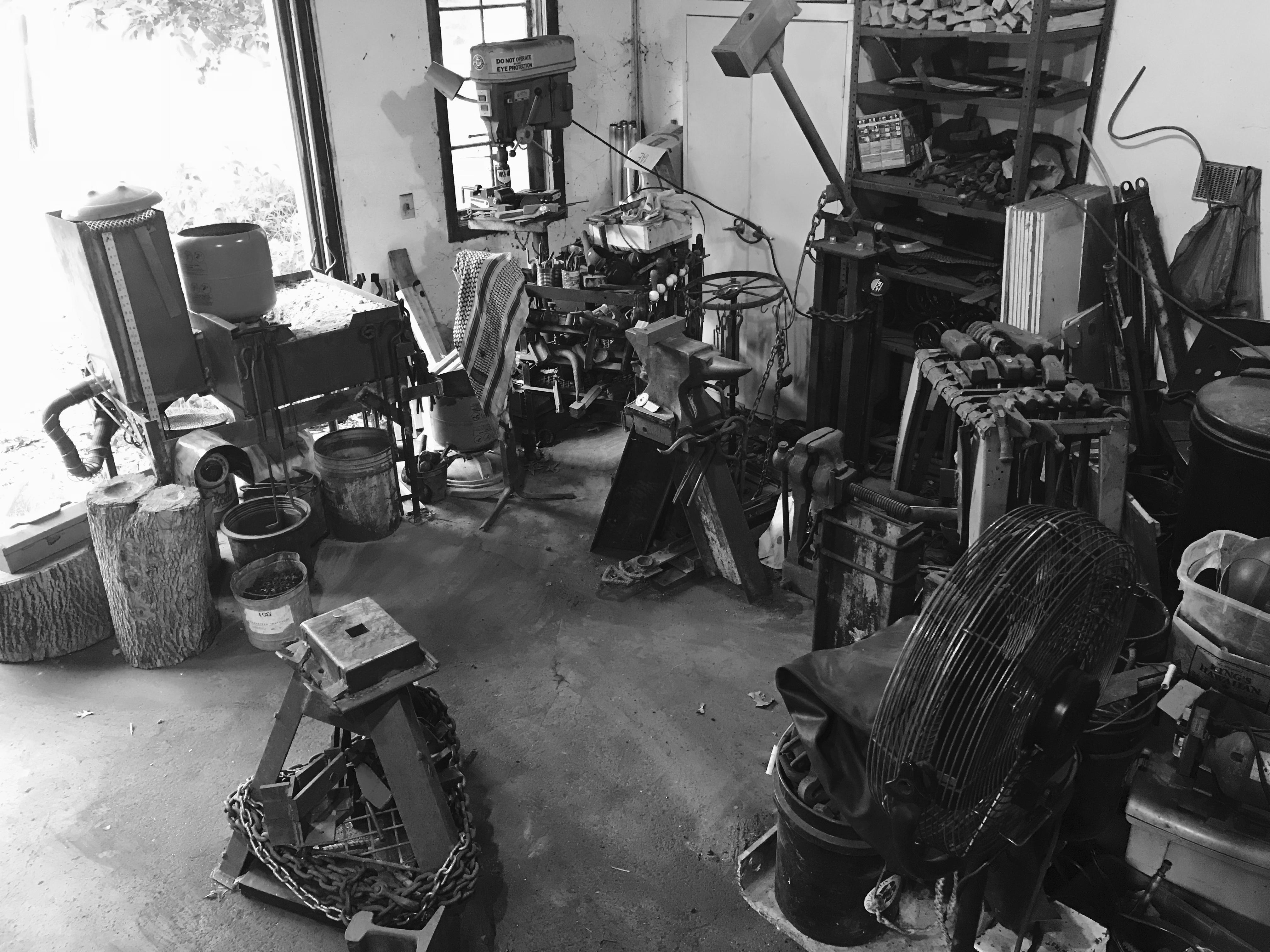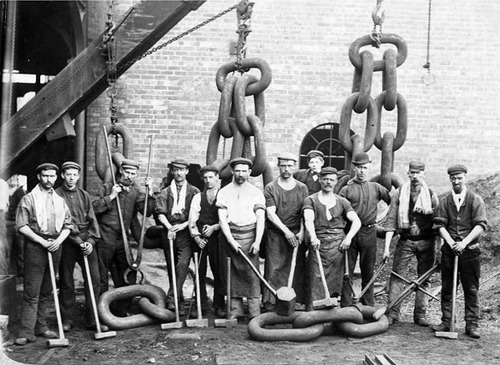-
Posts
19,312 -
Joined
-
Last visited
Content Type
Profiles
Forums
Articles
Gallery
Downloads
Events
Everything posted by JHCC
-
I had my anvil on a series of stumps for almost thirty years. I converted to the steel tripod a year and a half ago, and I'm never going back.
-
When the rubble of the World Trade Center was being cleaned up and carted away, they would occasionally find newspapers from the late 1970s that had been tucked into corners of the structure by workers on their lunch breaks.
-
-
Careful: it's not good for your health to be too sed(im)entary.
-
Please remember that refractory cement and hard-face refractory are not the same thing. The cement is typically for making things with firebrick, but usually isn't strong enough to hold up for long on its own. If you have more details (manufacturer, product name, etc), folks here can give you better information. If you've got sheet metal and can design & build anything you want, think seriously about a forge with a round or oval cross-section. The gas forge folks here will be able to help you more with this, but as I understand it, anyway, a rounded interior reflects more infrared towards the center, which gives you more efficient heating of steel in a blade. The ammo can forge is a great idea for using what you have, but don't get stuck on one idea if you have the flexibility to do something better -- even if that original idea seems really cool.
-

Fuel for the forge
JHCC replied to Curious Mind's topic in Solid Fuels: Coal, Coke, Charcoal, Wood, etc
Excellent! Now, go to your profile settings and add your location there. You've already seen how important that information is for answering questions, so you don't want to have to repeat it every single time! Welcome to IFI, and keep us posted on your progress. -
He's slated to join us later. Seriously, though, I have a 16lb. stone maul that I just acquired back in June, and it works great for heavy drawing out. The striking face (not the chisel edge) is nicely rounded, so it's basically an oversized rounding hammer. My son had his most successful striking session yet* using it a couple of nights ago. *Successful apart from destroying the portable hole, that is.
-

Question about Powder Metallurgy
JHCC replied to Meridianfrost's topic in Blacksmithing, General Discussion
In that case, you definitely don't want to be messing with powdered steels, canister damascus, etc. This isn't a reflection on you personally; it's an objective assessment of your skill level. One of the worst things about being a novice (and I'm speaking from personal experience here) is that you don't even know what you don't know. In fact, the more I learn, the more I learn how little I know (<<more Socrates). If you're serious about getting into knifemaking, @Meridianfrost, I've got two suggestions. First, invest in some proper knifemaking stock in a known alloy like 1084. The knifemakers here can give you recommendations for what's a good beginner's steel. Second (if you're looking for a low-cost option), make friends with a mechanic and get some coil springs (preferably unused, perhaps switched out from a lift kit job). Cut them into 6"-8" lengths and practice on those; you'll also be able to practice heat treatment and grinding, and you'll end up with an actual knife rather than a mild steel mockup. Just be aware that how one spring responds to heat treatment may not be the same as another from a different manufacturer. Either way, once you've got some good knifemaking experience under your belt, you'll be in a much better position to move on to canister damascus and patternwelding. In the mean time, keep posting and make sure to show us pictures of your progress! -
Now, go mount that thing on a heavy, stable stand and get to poundin'!
-
I made friends with my mechanic a while back by making him a bottle opener out of part a collapsible steering column, and he and his head assistant (for whom I just made a Jeep-themed bottle opener) call me whenever they have something they think I'd like. I've got more coil springs, torsion bars, axles, and steering linkages than I know what to do with, and my post vise is held to its stand with the U-bolts that used to hold the leaf springs on a big ol' truck.
-
Lower carbon steels don't behave under the hammer the same way higher carbon steels do. If you want a low-cost option, make friends with a mechanic and get some coil springs (preferably unused, perhaps switched out from a lift kit job). Cut them into 6"-8" lengths and practice on those; you'll also be able to practice heat treatment and grinding, and you'll end up with an actual knife rather than a mockup. Just be aware that how one spring responds to heat treatment may not be the same as another from a different manufacturer.
-
Also check out the Bargain Barn at Logan Steel in Meridan -- no blade steel, but for any kind of structural or bar stock, you'll be like a kid in a candy store. I stop by when I'm in CT on business.
-
Yeah, that's not just green. That's GREEN. And hey, if you're in Tom's River, you should take a drive up the Garden State to the Fisher & Norris Museum in Farmingdale. @njanvilman has an incredible collection that is well worth seeing.
-
Nice looking little anvil. Someone was obviously a John Deere fan. If you put your location in your profile settings, "prices seemed to be crazy where I am" will make more sense to the rest of us.
-
You are quite welcome -- and here's another one: the IFI curmudgeons are some of the most helpful, informative folks you will ever hope to meet and will gladly share every bit of what they know with you IF you do your research before asking a question. If you want to know something, take some time to see if you can find the answer first (pro tip: since the forum software search function is quirky, try using a search engine with "iforgeiron.com" as one of your search terms); if that doesn't get you a usable answer, at least you'll be able to ask a more detailed, informed, and specific question.
-

Blacksmith Techniques - Drawing Out
JHCC replied to 19Branden86's topic in Blacksmithing, General Discussion
These methods do require a fair degree of hammer control. Then again, they are also a great way to develop hammer control, as you get immediate feedback on what's working and what's not. Excellent advice. -
Welcome aboard! We have a number of members in CT and a fair few who are active in the New England Blacksmiths Association, so you've got a lot of people in your area who can help you get started. Please put your location in your profile settings, so folks know where you are; it also helps when you ask a question with a region-specific answer (like "How much is this anvil worth?"). There are a number of threads about anvil stands, so check them out for inspiration -- and make sure to post pictures of your work!
-

Another way to straighten coil springs
JHCC replied to JHCC's topic in Blacksmithing, General Discussion
That's certainly an interesting possibility. I've been thinking about a few options, but one advantage of the vise grips is how solidly they hold the workpiece. -
You've got to catch it on the fly. Non, nous avons reconnu l'asperge.
-
Are these to be decorative, or functional? If the former, mild steel should be fine. If the latter, I'd suggest sourcing new material from a spring shop.
-
Ah, Bach to the basics!
-
And we haven't even started talking about tempering chocolate.
-
Yes, that's right. For welding, though, you need transglutaminase.
-
If that's the anvil, how high did the ball bearing bounce?

